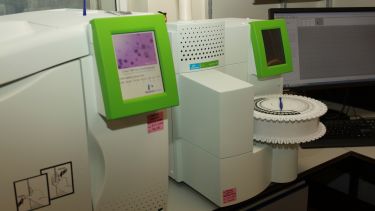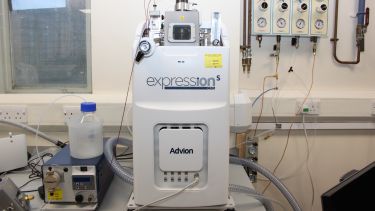Metabolomics instruments
Our full range of equipment includes:
Waters G2/G2Si Synapt
The Waters G2 Synapt is a state of the art high performance ion mobility orthogonal mass spectrometer with nano-spray and MALDI. The provision of an ion mobility cell between the trap cell and the transfer Waters G2 Synaptcell before the TOF provide both an unparalleled resolution and an ability to do complex MS/MS interrogation of molecules. The ability to change the source rapidly make it an excellent machine for metabolite work where a large range of classes of organic molecules are involved. The ion mobility function brings a new dimension to metabolomics experiments.
The instruments allow imaging using MALDI (matrix-assisted laser desorption ionisation) and DESI (desorption electrospray ionisation) techniques with high resolution and sensitivity.
Typical experiments include
- Non-targeted metabolic profiling
- UPLC-MS targeted analysis
- MS/MS analysis of ions for mass identification
- Analysis of isomers
- MALDI-MS/DESI-MS-imaging at single cell resolution
- Ion mobility
Perkin Elmer GC-MS
The quadrupole GC-MS adds to the wide analysis capability of the facility. It can measure volatile organic compounds in liquid samples and extracts using an automated liquid sampler and in gases using thermal desorption tubes. In particular the Perkin Elmer Clarus SQ 8 GC-MS can acquire a large number of spectra (12,500 amu/sec) across every GC peak allowing clear definition and quantification of chromatographic peaks to deliver exceptionally accurate and precise data. The instrument also analyses over a wide mass range (1-1200 u), with low detection limits.
Sample introduction techniques include
- Automated liquid sampler
- Automated thermal desorption
- Manual injection using SPME
PDZ Europa Sercon ANCA GSL 20-20
The PDZ Europa Sercon ANCA GSL 20-20 can measure the stable isotopes of carbon and nitrogen of solid, liquid and gas samples. In isotope ratio mass spectrometry, element isotope ratios are determined very accurately and precisely. Typically, single focusing magnetic sector mass spectrometers with fixed multiple detectors (one per isotope) are used. Complex compounds are reduced to simple molecules prior to measurement; for example, organic compounds are combusted to CO2, H2O and N2. The technique involves the coupling of a preparation system employing the Dumas principle with a stable isotope mass spectrometer. This allows the measurement of not only total nitrogen or carbon in a sample but also their 15N or 13C levels in a wide range of biological and chemical samples.
Portable Mass Spectrometers
Advion Expression S CMS
This compact quadrupole mass spectrometer (CMS) provides essential information quickly on a variety of samples including solid, liquids and gases. The mass spec allows users to switch rapidly between various sample introduction techniques with little sample preparation. The instrument is portable and has it’s own nitrogen generator allowing it to be used out in the field for rapid analysis.
Sample introduction techniques include
- Atmospheric Solids Analysis Probe (ASAP)
- Volatile APCI (vAPCI)
- Direct Injection (ESI)
Torion
The Torion® T-9 GC-MS is the world's smallest portable GC-MS, and is fast, reliable, and easy to use. The integrated system features a low thermal mass capillary gas chromatograph with high-speed temperature programming and a miniaturized toroidal ion trap mass spectrometer (TMS) with a mass range from 41 to 500 Daltons. Samples are injected using a novel CUSTODION® solid phase microextraction (SPME) fiber syringe or a needle trap (CUSTODION-NT).
The Torion T-9 GC-MS system is totally self-contained, weighs 32 pounds, and is rechargeable battery operated. It is easy to operate, with a colour touch screen user interface or a simple three button navigation. The system's speed and portability makes it ideal for analysis outside of the lab.





